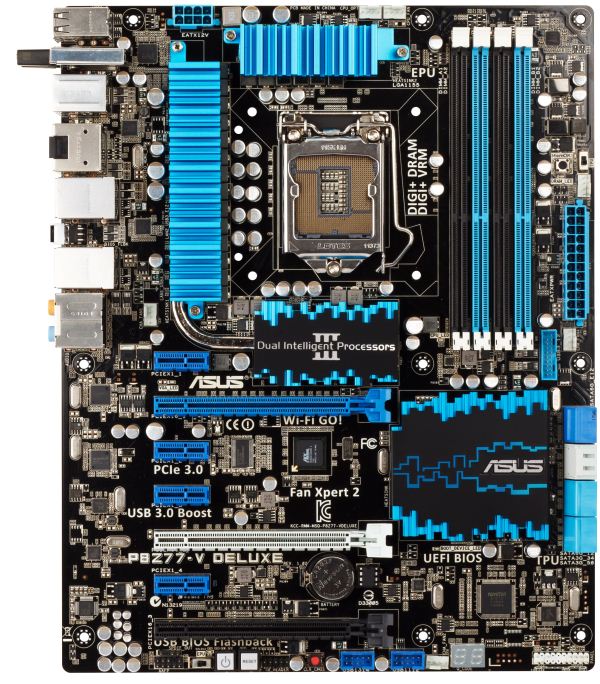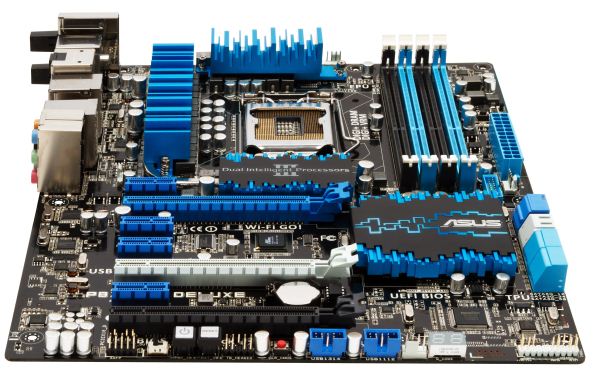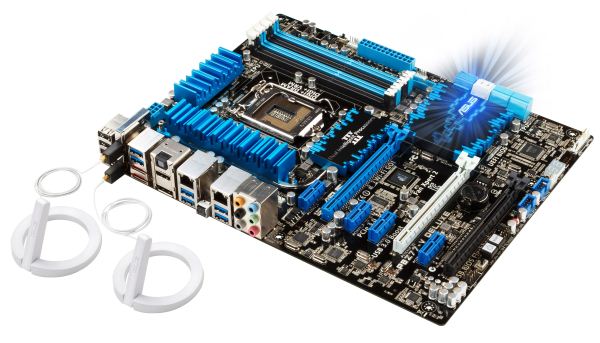Intel Z77 Panther Point Chipset and Motherboard Preview – ASRock, ASUS, Gigabyte, MSI, ECS and Biostar
by Ian Cutress on April 8, 2012 12:00 AM EST- Posted in
- Motherboards
- Intel
- Biostar
- MSI
- Gigabyte
- ASRock
- Asus
- Ivy Bridge
- ECS
- Z77
ASUS P8Z77-V Deluxe—Visual Inspection
In the next notch up in the channel board segregation, ASUS sell the Deluxe. This will be the first ASUS Deluxe board we have reviewed at AnandTech since the Llano mini-ITX F1A75-I Deluxe last year. In comparison to the P8Z77-V Pro, the Deluxe features several upgrades in terms of functionality and comfort.
The first to note is the increased power delivery to the CPU—this time in the form of a 16 + 4 phase power delivery. As a result, the VRM heatsinks to the left of the CPU are directly connected via a heatpipe to another heatsink below the socket. Also on board are the ‘enthusiast’ power/reset buttons and two-digit debug that we did not see on the Pro, and the use of dual NICs on the I/O, in the form of an Intel 82579V and a Realtek 8111F.
Due to the positioning off the heatsinks on the Deluxe compared to the Pro, the socket area seems a bit smaller (for example, the left hand heatsink is moved further in towards the socket), meaning that big air coolers may have a tougher time if they do not fit into Intel’s socket specification. Around the socket itself, we still have access to five fan headers—two 4-pin on the top of the board, one 4-pin to the bottom left of the main VRM heatsink, and one 4-pin either side of the 24-pin ATX power connector. A sixth fan header on board is found at the bottom next to the two-digit debug output.
Above the main power connector on the right hand side are the MemOK button and the TPU switch (for a fast automatic overclock). Below it is a USB 3.0 header, and a set of eight SATA ports. Similar to the ASUS Pro, we have four SATA 3 Gbps from the PCH, two SATA 6 Gbps also from the PCH, and two SATA 3 Gbps from a different controller—the Marvell 9128. This allows RAID 0/1 on these two SATA 6 Gbps ports.
The south side of the board still contains front panel headers and USB 2.0 ports, but also comes with the aforementioned power/reset buttons and two-digit debug display. We also find a ClearCMOS button on board, useful for overclockers. There is also a header labelled 'TB_Header', which should mean Thunderbolt, but there is no mention of it in the specifications. I will have to check up on this.
Update: The TB_Header is actually for a new Thunderbolt add-in card that ASUS will be selling. This is aimed to go into the x4 slot and provide Thunderbolt connectivity. MSRP will be around the $30-$40 mark so I am told.
In terms of the PCIe, we have a little bit of confusion. While in the middle between the PCIe is a PLX chip, it is not the PLX PXE 8747 chip that increases PCIe lane count. The one on the Deluxe is just to provide extra data transfer access for the various controllers on the motherboard. This means that the third full length PCIe in black is like other boards in that this is a PCIe 2.0 x4, non-GPU port. So from the top, we have a PCIe x1, x16 (x8 in Multi-GPU), x1, x1, x8, x1, x4. As a result, there is no PCIe to PCI bridge chip on this high-end model for PCI slots.
For the back panel, ASUS have done a juggling act deciding what to include. On the far left is a set of four USB 2.0 ports (black), a mini-PCIe WiFi + Bluetooth module, two USB 3.0 (blue), two eSATA, optical SPDIF output, HDMI output, DisplayPort, dual gigabit Ethernet, another four USB 3.0 ports (blue), a BIOS flashback button, and audio outputs. So in the name of a double NIC and 10 total USB ports on the back panel, we have lost D-Sub, DVI, IEEE1394 and a ClearCMOS button.
Board Features
| ASUS P8Z77-V Deluxe | |
| Size | ATX |
| CPU Interface | LGA-1155 |
| Chipset | Intel Z77 |
| Power Delivery | 16 + 4 |
| Memory Slots |
Four DDR3 DIMM slots supporting up to 32 GB Up to Dual Channel |
| Video Outputs | DisplayPort, HDMI |
| Onboard LAN |
Intel 82579V Realtek 8111F |
| Onboard Audio | Realtek ALC898 |
| Expansion Slots |
2 x PCIe x16 Gen3 (x16, x8/8) 1 x PCIe x16 Gen2 (x4) 4 x PCIe x1 Gen2 |
| Onboard SATA/RAID |
2 x SATA 6 Gbps (PCH), Support for RAID 0, 1, 5, 10 2 x SATA 6 Gbps (Marvell PCIe 9128), RAID 0, 1 4 x SATA 3 Gbps (PCH), Support for RAID 0, 1, 5, 10 2 x eSATA 6 Gbps (ASMedia) |
| USB |
Four USB 3.0 at rear (2 PCH, 2 ASMedia) Two USB 3.0 headers on board (PCH, ASMedia) Eight USB 2.0 (4 back panel, 4 on board) |
| Onboard |
4 x SATA 6 Gbps 4 x SATA 3 Gbps 1 x USB 3.0 Headers 2 x USB 2.0 Headers 6 x Fan Headers 1 x SPDIF Header 1 x Front Panel Audio Header 1 x TB Header MemOK! Button TPU/EPU Switches USB Flashback Button Power/Reset Buttons |
| Power Connectors |
1 x 24-pin ATX connector 1 x 8-pin 12V connector |
| Fan Headers |
1 x CPU Fan Header (4-pin) 4 x CHA Fan Headers 1 x OPT Fan Header |
| IO Panel |
2 x eSATA 6 Gbps 1 x DisplayPort 1 x HDMI 1.4a 2 x Gigabit Ethernet 6 x USB 3.0 4 x USB 2.0 1 x Optical SPDIF Audio Outputs Bluetooth V4.0 Wifi USB Flashback |
| Warranty Period | 3 Years |
| Product Page | Link |
Obviously one of the main selling points of the board is the onboard WiFi and Intel NIC (alongside a Realtek NIC).














145 Comments
View All Comments
Zoomer - Tuesday, April 10, 2012 - link
It doesn't matter, firewire maxes out at 800Mbps, which the PCI standard can easily handle ht 133 MBps.Of course, shared bandwidth is an issue, but reworking designs / buying the PCIe design rises issues of cost and reduces the number of PCIe lanes for other devices that can better use the bandwidth.
prophet001 - Monday, April 9, 2012 - link
Seeing at the layer that Virtu is running and reading about what it claims to be capable of, is there any reason this could not cure once and for all the micro-stutter associated with multiple video cards?jonyah - Monday, April 9, 2012 - link
It's good to know my Z68 (asus maximus iv-extreme) still hasn't been bested. I see nothing from any of these boards that beats what I've been running for some time now. Plus i have more usb 3.0 ports (12 to be exact).flashbacck - Monday, April 9, 2012 - link
For my own PC, I'm interested in seeing what mATX sized Z77 boards there are. Often they have weird expansion slot combinations or positions. Looking at what Z68 boards are out now, it surprises me how many still have PCI slots. I would've thought they'd be replaced by PCIe 1x's by now.Also, anything about UEFI bios implementations? Was the promise of fast booting UEFI bioses ever fulfilled?
Aruneh - Friday, April 13, 2012 - link
I'm planning on making my next build a mATX one, and would be interested in seeing some reviews of high quality boards with lots of features. The Gigabyte mentioned in this article sadly seems to be a cheaper model.CharonPDX - Monday, April 9, 2012 - link
"...including 8800 and 2400 series..."What, are we back in 2007?
Oh, wait... AMD 8800 and nVidia 2400, not the other way around...
Wait, that's not right either. What's the 2400 referring to?
Ryan Smith - Tuesday, April 10, 2012 - link
Radeon HD 2400; AMD's low end series for the HD 2000 generation in 2007.extide - Tuesday, April 10, 2012 - link
You had it right the first time... That phrase in the article was specifically pointing out the broad range of compatibility of the Lucid solution.extide - Tuesday, April 10, 2012 - link
The first time as in in 8800 = nVidia, and 2400 = AMDkristof007 - Monday, April 9, 2012 - link
I don't know if this helps or you wan to put an update but NewEgg has the boards out and prices on them (I am not sure if they sell it at MSRP or not). Just a thought if you want to update those "TBC" prices.